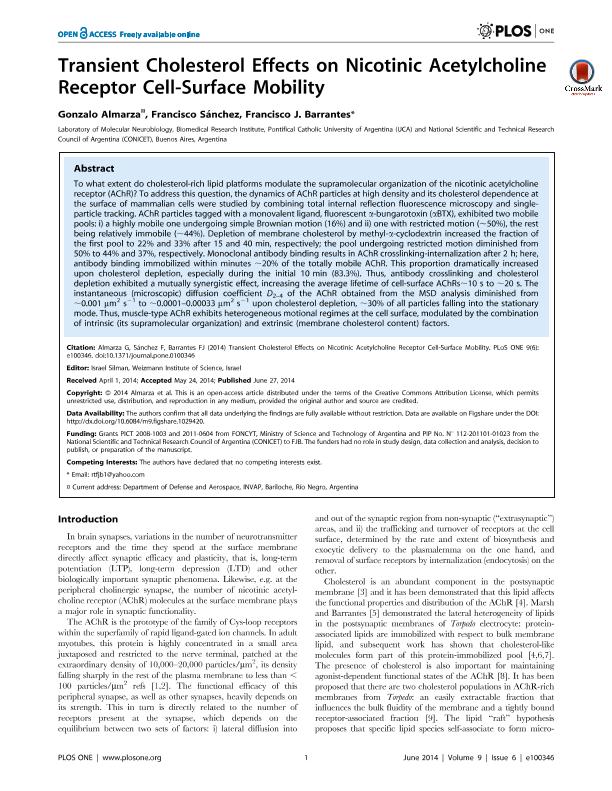Mostrar el registro sencillo del ítem
dc.contributor.author
Almarza, Gonzalo

dc.contributor.author
Sánchez, Francisco

dc.contributor.author
Barrantes, Francisco Jose

dc.date.available
2018-01-25T17:51:16Z
dc.date.issued
2014-06
dc.identifier.citation
Almarza, Gonzalo; Sánchez, Francisco; Barrantes, Francisco Jose; Transient Cholesterol Effects on Nicotinic Acetylcholine Receptor Cell-Surface Mobility; Public Library of Science; Plos One; 9; 6; 6-2014; 1-18; e100346
dc.identifier.issn
1932-6203
dc.identifier.uri
http://hdl.handle.net/11336/34606
dc.description.abstract
To what extent do cholesterol-rich lipid platforms modulate the supramolecular organization of the nicotinic acetylcholine receptor (AChR)? To address this question, the dynamics of AChR particles at high density and its cholesterol dependence at the surface of mammalian cells were studied by combining total internal reflection fluorescence microscopy and single-particle tracking. AChR particles tagged with a monovalent ligand, fluorescent α-bungarotoxin (αBTX), exhibited two mobile pools: i) a highly mobile one undergoing simple Brownian motion (16%) and ii) one with restricted motion (~50%), the rest being relatively immobile (~44%). Depletion of membrane cholesterol by methyl-α-cyclodextrin increased the fraction of the first pool to 22% and 33% after 15 and 40 min, respectively; the pool undergoing restricted motion diminished from 50% to 44% and 37%, respectively. Monoclonal antibody binding results in AChR crosslinking-internalization after 2 h; here, antibody binding immobilized within minutes ~20% of the totally mobile AChR. This proportion dramatically increased upon cholesterol depletion, especially during the initial 10 min (83.3%). Thus, antibody crosslinking and cholesterol depletion exhibited a mutually synergistic effect, increasing the average lifetime of cell-surface AChRs~10 s to ~20 s. The instantaneous (microscopic) diffusion coefficient D2-4 of the AChR obtained from the MSD analysis diminished from ~0.001 µm2 s-1 to ~0.0001-0.00033 µm2s-1 upon cholesterol depletion, ~30% of all particles falling into the stationary mode. Thus, muscle-type AChR exhibits heterogeneous motional regimes at the cell surface, modulated by the combination of intrinsic (its supramolecular organization) and extrinsic (membrane cholesterol content) factors.
dc.format
application/pdf
dc.language.iso
eng
dc.publisher
Public Library of Science

dc.rights
info:eu-repo/semantics/openAccess
dc.rights.uri
https://creativecommons.org/licenses/by/2.5/ar/
dc.subject
Acetylcholine Receptor
dc.subject
Single Particle Tracking
dc.subject
Mobility
dc.subject
Membrane
dc.subject.classification
Otras Ciencias Biológicas

dc.subject.classification
Ciencias Biológicas

dc.subject.classification
CIENCIAS NATURALES Y EXACTAS

dc.title
Transient Cholesterol Effects on Nicotinic Acetylcholine Receptor Cell-Surface Mobility
dc.type
info:eu-repo/semantics/article
dc.type
info:ar-repo/semantics/artículo
dc.type
info:eu-repo/semantics/publishedVersion
dc.date.updated
2018-01-24T18:58:33Z
dc.journal.volume
9
dc.journal.number
6
dc.journal.pagination
1-18; e100346
dc.journal.pais
Estados Unidos

dc.journal.ciudad
San Francisco
dc.description.fil
Fil: Almarza, Gonzalo. Invap S. E.; Argentina. Pontificia Universidad Católica Argentina ; Argentina
dc.description.fil
Fil: Sánchez, Francisco. Pontificia Universidad Católica Argentina ; Argentina
dc.description.fil
Fil: Barrantes, Francisco Jose. Pontificia Universidad Católica Argentina ; Argentina
dc.journal.title
Plos One

dc.relation.alternativeid
info:eu-repo/semantics/altIdentifier/url/http://journals.plos.org/plosone/article?id=10.1371/journal.pone.0100346
dc.relation.alternativeid
info:eu-repo/semantics/altIdentifier/doi/http://dx.doi.org/10.1371/journal.pone.0100346
Archivos asociados
